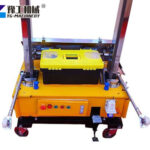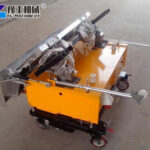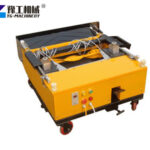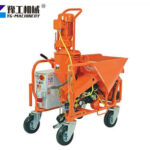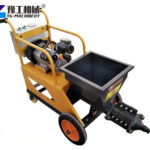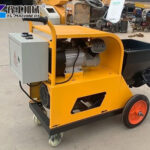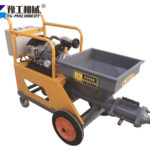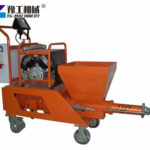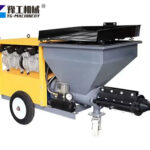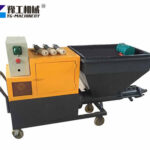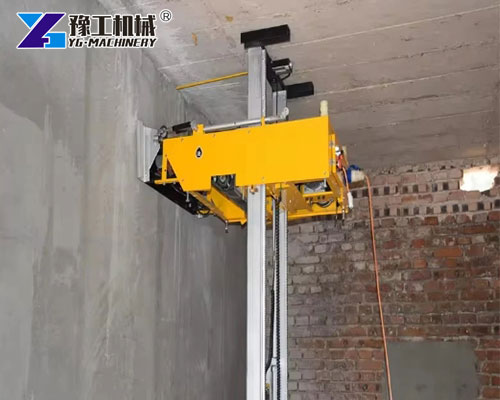
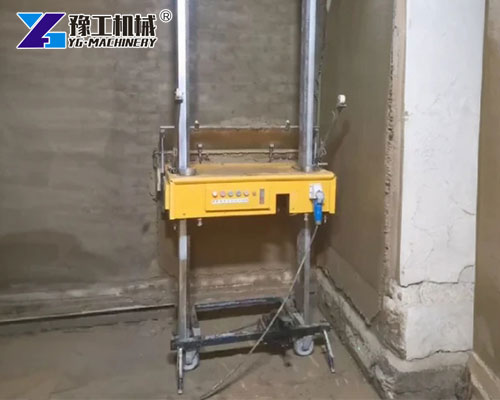
The automatic wall plastering machine is a tool that helps with plastering walls. It can put plaster or mortar on walls and other surfaces. It works much faster than manual methods and can be used on both vertical and horizontal surfaces. The wall plastering machine is commonly used in residential, commercial, and industrial projects to create smooth, durable finishes on walls and ceilings. Contact us via WhatsApp/WeChat at +86 138 3715 9132
Automatic Wall Plastering Machine Parameter
| Model | YG-800 | YG-1000 |
| Plastering height | Below 4 meters | Below 5 meters |
| Weight | 270 kg | 290 kg |
| Plastering thickness | 2~30 mm | 2~30 mm |
| Power | 1.5 KW | 1.5 KW |
| Plastering efficiency | 500 CBM/8H | 550 CBM/8H |
| Voltage | 220V/380V optional | 220V/380V optional |
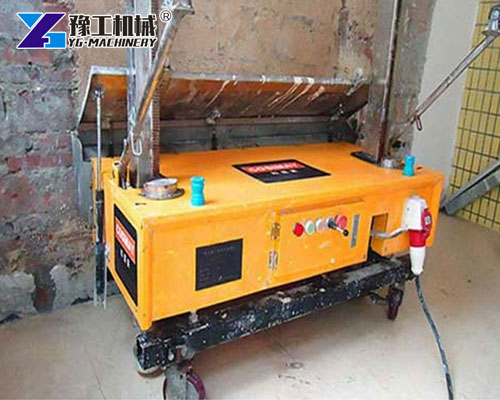
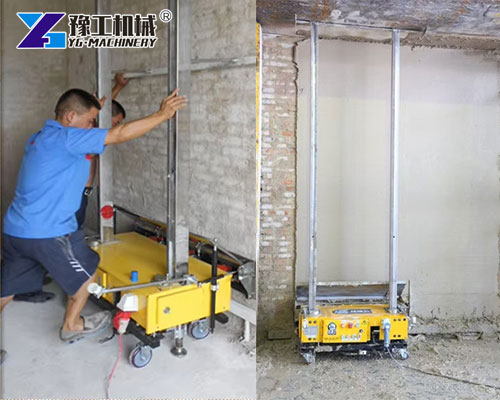
Automatic wall plastering machines feature
High efficiency: Fast, continuous work without fatigue, finishing large areas quickly.
Quality assurance: Uniform thickness (±1-2mm error) and high surface smoothness via precise control.
Easy operation: Simple to learn, flexible for corners and narrow spaces.
Cost-effective: Reduces labor and material waste, with long-term savings.
How a Plaster Wall Machine Works
Material Conveying System
Mortar is pumped by a built-in pumping device to the plastering mechanism, continuously delivering materials to the construction site.
Plastering Mechanism
Driven by a motor, scrapers or trowels move along preset trajectories, speeds, and angles to evenly apply mortar onto walls. Some machines use vibration devices to improve mortar filling and adhesion.
Control Technology
Sensors detect plaster thickness, while mechanical limit devices regulate the movement range of scrapers/trowels, ensuring uniform thickness and precise plastering.
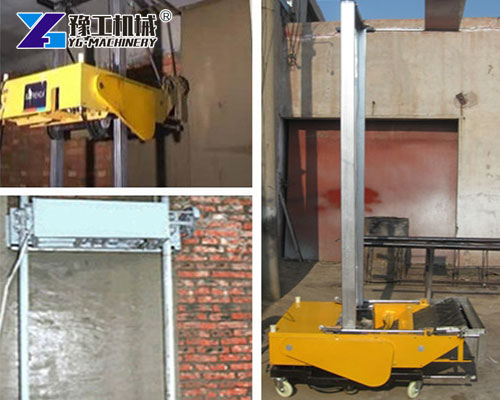
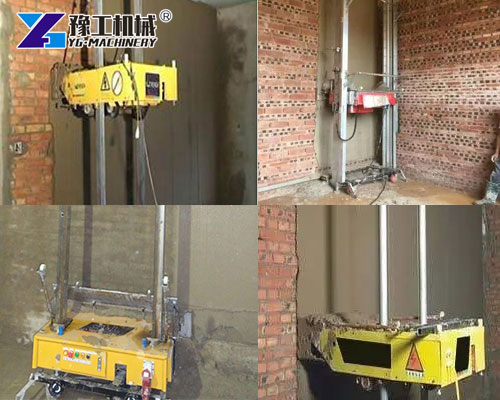
Where Are Cement Wall Plastering Machines Needed
Cement wall plastering machines are versatile tools for projects that demand strong, long-lasting finishes. Common applications include:
Building Exteriors: The cement layer applied by the machine is waterproof and UV-resistant, protecting walls from harsh weather.
Factories and Warehouses: These machines create durable surfaces that withstand daily wear, chemical exposure, and heavy use.
Retaining Walls and Underground Structures: They apply crack-resistant coatings to prevent water damage and erosion.
Decorative Finishes: Some models can create textured patterns for stylish concrete walls in homes or commercial spaces.
How to Use the Automatic Wall Plastering Machine
Before You Start
Prepare the Wall
For walls that soak up water, lightly spray them with water 2–3 days before plastering. Skip this step for walls that don’t absorb water (like painted or sealed walls).
Mark guide points or stick small nails on the wall to help line up the machine.
Check the Machine
The machine is already set to stay level when you get it. Don’t change these settings unless something’s wrong.
Step-by-Step Guide
Set Up the Machine
Place the machine on a flat indoor surface and do a test run without materials.
Line up the machine’s base with the marks you made on the wall. Push the machine snugly against the wall using the handle.
Attach and tighten the adjustable rods between the machine’s upright pole and the base.
Add the Plaster Mix
Fill the machine’s bucket (hopper) until the plaster reaches the top opening. Keep the area around the poles clean to avoid clogs.
Don’t fill the hopper on your first try – leave some space at the top. Adjust the amount based on how thick or high you need the plaster.
Turn It On
If the machine stops immediately after turning it on, the power wires might be reversed. Ask an electrician to fix this.
Press and hold the start button to turn on both the shaking function (to spread plaster evenly) and the belt that carries the plaster upward.
While It’s Working
As the machine moves up, use the controls to pause the plaster flow now and then. This reduces the mess on the floor.
The machine stops adding plaster automatically when it’s 50 cm from the ceiling. The smoothing tool will tilt slightly to finish the job.
If the bucket runs low, the machine will stop or lower itself to let you refill it.
Helpful Tips
Have someone experienced guide you the first time you use the machine.
Check every 2 hours that all rods and parts are tightly secured.
After each use, clean the bucket and the plaster-moving parts thoroughly.
(Note: These are general steps. Always check the manual for your specific machine model.)
Why Choose Automatic Plastering Over Manual Work?
Automatic wall plastering machine makes plastering faster, cheaper, and more reliable:
Speed: Finish 100–200 square meters per hour, 10 times faster than manual labor.
Fewer Workers: Replace a team of 5–6 workers with just 1–2 operators.
Less Waste: Precise spraying uses only the required amount of material.
Smooth Results: No uneven patches or air bubbles, even on large surfaces.
For big projects like apartments or offices, these machines cut costs and save weeks of work.
What Affects the Price of an Automatic Plastering Machine?
Prices vary depending on the machine’s capabilities:
Size and Power: Heavy-duty models (200+ m²/day) range from $8,000 to $15,000.
Smart Features: GPS tracking, automatic mixing, or remote controls add to the cost.
While the upfront cost is higher than manual tools, the machine pays for itself by reducing labor and speeding up projects.
Why choose YG Auto Wall Plastering Machine
YG Machinery manufactures automatic wall plastering machines for commercial, residential, and industrial projects, offering fast positioning, high-quality finishes, and labor-saving efficiency. Our portfolio combines innovative technology with cost-effective solutions to streamline construction workflows. Contact us for factory-direct pricing on automatic wall plastering. Contact us via WhatsApp/WeChat at +86 138 3715 9132

